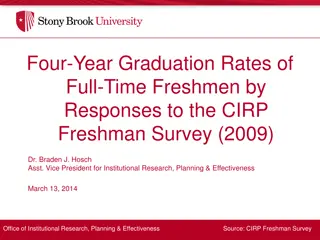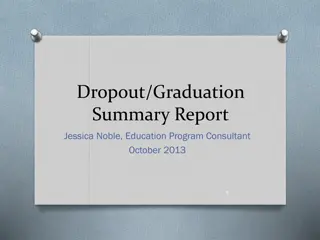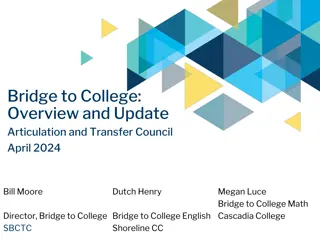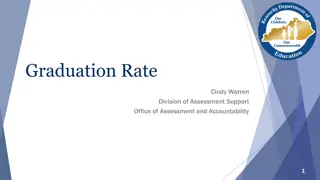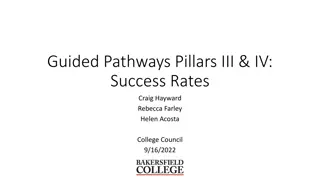Understanding College Graduation Rates and Their Impact on Student Success
College choice plays a critical role in a student's likelihood of success, with institutional graduation rates serving as key indicators. Students are more likely to graduate from colleges with higher graduation rates, underscoring the importance of selecting schools with strong support systems tailored to individual backgrounds. The data presented highlights the variation in graduation rates among different colleges based on selectivity categories, emphasizing the need for students to make informed decisions when choosing an institution.
- College graduation rates
- Student success
- Institutional support
- Selectivity categories
- Higher education
Download Presentation

Please find below an Image/Link to download the presentation.
The content on the website is provided AS IS for your information and personal use only. It may not be sold, licensed, or shared on other websites without obtaining consent from the author. Download presentation by click this link. If you encounter any issues during the download, it is possible that the publisher has removed the file from their server.
E N D
Presentation Transcript
The Importance of Institutional Graduation Rates for College Completion
College choice matters a great deal Even students with high GPAs in high school are still likely to fail if they choose colleges with a low overall/ institutional graduation rate. A school s institutional graduation rate can differ across subgroups, so it is important for students to choose schools with strong supports for their particular background and qualifications. 2
A colleges overall graduation rate is a strong indicator of an individual student s likelihood to graduate Similar students who choose a college with a higher institutional graduation rate are up to more likely to graduate from college Source: Roderick, M., et al. (2008). From high school to the future: Potholes on the road to college. Chicago, IL: University of Chicago Consortium on School Research 3
Institutional graduations rates vary within selectivity bands* 2014 6-yr URM Graduation Rate 2014 6-yr Institutional Graduation Rate College Name Selectivity Category Columbia College Chicago Non-Selective 43% 34% Northeastern Illinois University Somewhat Selective 22% 15% Northern Illinois University Somewhat Selective 50% 32% Southern Illinois University Carbondale** Somewhat Selective 44% 33% Chicago State University Somewhat Selective 19% 18% Western Illinois University Somewhat Selective 54% 48% University of Illinois at Chicago Selective 60% 52% DePaul University Selective 71% 68% Illinois State University Selective 72% 60% University of Illinois at Urbana-Champaign Very Selective 84% 77% * For top 10 4-year colleges attended by CPS students 4 National Center for Education Statistics
Institutional graduations rates vary within selectivity bands* 2014 6-yr URM Graduation Rate 2014 6-yr Institutional Graduation Rate College Name Selectivity Category Columbia College Chicago Non-Selective 43% 34% Northeastern Illinois University Somewhat Selective 22% 15% Northern Illinois University Somewhat Selective 50% 32% Southern Illinois University Carbondale** Somewhat Selective 44% 33% Chicago State University Somewhat Selective 19% 18% Western Illinois University Somewhat Selective 54% 48% University of Illinois at Chicago Selective 60% 52% DePaul University Selective 71% 68% Illinois State University Selective 72% 60% University of Illinois at Urbana-Champaign Very Selective 84% 77% * For top 10 4-year colleges attended by CPS students 5 National Center for Education Statistics
Institutional graduation rates also vary widely for students with the same GPA Institutional graduation rates across top CPS receiving institutions for students with the same high school GPA of 3.0 62% 49% 47% 41% 41% 40% 40% 35% 24% 13% 6 Source: Roderick, M., et al. (2008). From high school to the future: Potholes on the road to college. Chicago, IL: University of Chicago Consortium on School Research. .
Many 4-year Illinois colleges are improving their graduation rates for underrepresented minority students Six-year Underrepresented Minority (URM) Graduation Rate +9pts 77% +15pts +7pts 68% 68% +13pts 60% +2pts 53% 53% 52% 48% 46% +12pts +3pts 39% 34% 33% 30% 22% 2014 2014 2014 2014 2014 2014 2014 2006 2006 2006 2006 2006 2006 2006 University of Illinois at Chicago Southern Illinois University Carbondale University of Illinois at Urbana-Champaign DePaul University Illinois State University Western Illinois University Columbia College Chicago 7 National Center for Education Statistics. See toandthrough.uchicago.edu/data/references for details.
More CPS graduates have enrolled in 4-year colleges with institutional graduations rates above 50% Percentages of CPS graduates who enrolled in colleges with six-year institutional graduation rates of 50% or higher, 2006 vs. 2015 2015 67% 2006 58% Source: Nagaoka, J., Seeskin, A., & Coca, V.M. (2017). The educational attainment of Chicago Public Schools students: 2016. Chicago, IL: University of Chicago Consortium on School Research 8
Ultimately, a colleges overall graduation rate is just one factor to consider in the process of finding a good college match, but it can signal how well a college can support students in their quests to graduate from college. A key question for students to ask as they re considering colleges: Of the students who enroll here, how many of them graduate, particularly students like me? 9











